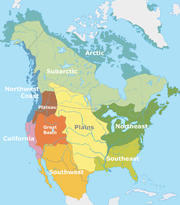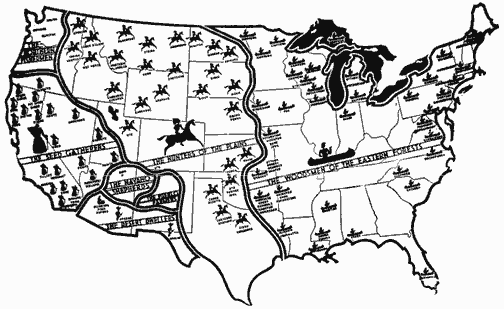
Cultural area
Encyclopedia


Region
Region is most commonly found as a term used in terrestrial and astrophysics sciences also an area, notably among the different sub-disciplines of geography, studied by regional geographers. Regions consist of subregions that contain clusters of like areas that are distinctive by their uniformity...
(area
Area
Area is a quantity that expresses the extent of a two-dimensional surface or shape in the plane. Area can be understood as the amount of material with a given thickness that would be necessary to fashion a model of the shape, or the amount of paint necessary to cover the surface with a single coat...
) with one relatively homogeneous human activity or complex of activities (culture
Culture
Culture is a term that has many different inter-related meanings. For example, in 1952, Alfred Kroeber and Clyde Kluckhohn compiled a list of 164 definitions of "culture" in Culture: A Critical Review of Concepts and Definitions...
). These areas are primarily geographical, not historical (but see below), and they are not considered equivalent to Kulturkreis
Kulturkreis
The Kulturkreis school was a central idea of the early 20th-century Austrian school of anthropology that sought to redirect the discipline away from the quest for an underlying, universal human nature toward a concern with the particular histories of individual societies...
(Culture circles).
Development
A culture area is a concept in cultural anthropologyCultural anthropology
Cultural anthropology is a branch of anthropology focused on the study of cultural variation among humans, collecting data about the impact of global economic and political processes on local cultural realities. Anthropologists use a variety of methods, including participant observation,...
where a geographic region and time sequence (age area) is characterized by substantially uniform environment and culture. The concept of culture areas was originated by museum curators and ethnologists during the late 1800s as means of arranging exhibits. Clark Wissler
Clark Wissler
Clark Wissler was an American anthropologist.Born near Hagerstown, Indiana, Wissler graduated from Indiana University in 1897. He received his doctorate in psychology from Columbia University in 1901. After Columbia, Wissler left the field of psychology to focus on Anthropology...
and Alfred Kroeber further developed the concept on the premise that they represent long-standing cultural divisions. The concept is criticized by some, who argue that the basis for classification is arbitrary. But other researchers disagree and the organization of human communities into cultural areas remains a common practice throughout the social sciences. The definition of culture areas is enjoying a resurgence of practical and theoretical interest as social scientists conduct more research on processes of cultural globalization.
Music
A music area is a cultural area defined according to musical activity, and may or may not conflict with the cultural areas assigned to a given region. The world may be divided into three large music areas, each containing a "cultivated" or classical musics "that are obviously its most complex musical forms," with, nearby, folkFolk music
Folk music is an English term encompassing both traditional folk music and contemporary folk music. The term originated in the 19th century. Traditional folk music has been defined in several ways: as music transmitted by mouth, as music of the lower classes, and as music with unknown composers....
styles which interact with the cultivated, and, on the perimeter, primitive
Prehistoric music
Prehistoric music is a term in the history of music for all music produced in preliterate cultures , beginning somewhere in very late geological history...
styles:
- Europe and Sub-Saharan AfricaMusic of AfricaAfrica is a vast continent and its regions and nations have distinct musical traditions. The music of North Africa for the most part has a different history from sub-Saharan African music traditions....
- based on shared isometricIsometreIsometre is a music theory term describing the use of pulse without regular meter. See also: homorhythm. The music is currently used in the psalmsongs of the Orthodox Reformed Churches in the Netherlands, based on the rhythm made by Petrus Datheen , as well as some other churches....
materials, diatonic scaleDiatonic scaleIn music theory, a diatonic scale is a seven note, octave-repeating musical scale comprising five whole steps and two half steps for each octave, in which the two half steps are separated from each other by either two or three whole steps...
s, and polyphonyPolyphonyIn music, polyphony is a texture consisting of two or more independent melodic voices, as opposed to music with just one voice or music with one dominant melodic voice accompanied by chords ....
based on parallelParallel keyIn music, parallel keys are the major and minor scales that have the same tonic. A major and minor scale sharing the same tonic are said to be in a parallel relationship...
thirdThirdThird may refer to:*3 , such as the 3rd of something -see also Ordinal number *Fraction , such as 1/3*1/60 of a second, or 1/3,600 of a minute *Third World, economically underdeveloped nations...
s, fourthsPerfect fourthIn classical music from Western culture, a fourth is a musical interval encompassing four staff positions , and the perfect fourth is a fourth spanning five semitones. For example, the ascending interval from C to the next F is a perfect fourth, as the note F lies five semitones above C, and there...
, and fifthsPerfect fifthIn classical music from Western culture, a fifth is a musical interval encompassing five staff positions , and the perfect fifth is a fifth spanning seven semitones, or in meantone, four diatonic semitones and three chromatic semitones...
.
- based on shared isometric
- North AfricaMusic of North AfricaNorth Africa has contributed much to popular music, especially Egyptian classical and el Gil, Algerian raï and Moroccan chaabi. The broad region is sometimes called the Maghreb , and the term Maghrebian music is in use. For a variety of reasons, Tunisia and Libya do not have as extensive a...
, Southwest Asia, South Asia, and IndonesiaMusic of IndonesiaThe music of Indonesia demonstrates its cultural diversity, the local musical creativity, as well as subsequent foreign musical influences that shaped contemporary music scenes of Indonesia. Nearly thousands of Indonesian islands having its own cultural and artistic history and character. This...
.- based on shared small intervalsInterval (music)In music theory, an interval is a combination of two notes, or the ratio between their frequencies. Two-note combinations are also called dyads...
in scales, melodiesMelodyA melody , also tune, voice, or line, is a linear succession of musical tones which is perceived as a single entity...
, and polyphony.
- based on shared small intervals
- American IndianNative American musicAmerican Indian music is the music that is used, created or performed by Native North Americans, specifically traditional tribal music. In addition to the traditional music of the Native American groups, there now exist pan-tribal and inter-tribal genres as well as distinct Indian subgenres of...
, East Asia, Northern SiberianInuit musicTraditional Inuit music, the music of the Inuit, has been based around drums used in dance music as far back as can be known, and a vocal style called katajjaq has become of interest in Canada and abroad....
, and Finno-Ugric music- based on shared large stepsSteps and skipsIn music, a step, or conjunct motion, is a linear or successive interval between two pitches which are consecutive scale degrees. Any larger interval is called a skip , or disjunct motion...
in pentatonicPentatonic scaleA pentatonic scale is a musical scale with five notes per octave in contrast to a heptatonic scale such as the major scale and minor scale...
and tetratonicMusical scaleIn music, a scale is a sequence of musical notes in ascending and descending order. Most commonly, especially in the context of the common practice period, the notes of a scale will belong to a single key, thus providing material for or being used to conveniently represent part or all of a musical...
scales.
- based on shared large steps
However, he then adds that "the world-wide development of music must have been a unified process in which all peoples participated," and that one finds similar tunes and traits in puzzlingly isolated or separated locations throughout the world.
See also
- Culture areas of North America
- List of music areas in the United States
- SprachbundSprachbundA Sprachbund – also known as a linguistic area, convergence area, diffusion area or language crossroads – is a group of languages that have become similar in some way because of geographical proximity and language contact. They may be genetically unrelated, or only distantly related...
- Julian StewardJulian StewardJulian Haynes Steward was an American anthropologist best known for his role in developing "the concept and method" of cultural ecology, as well as a scientific theory of culture change.-Early life and education:...
- Melville J. HerskovitsMelville J. HerskovitsMelville Jean Herskovits was an American anthropologist who firmly established African and African American studies in American academia. The son of Jewish immigrants, he obtained a Bachelor of Philosophy at the University of Chicago in 1923 and obtained his Master's and Ph.D...

